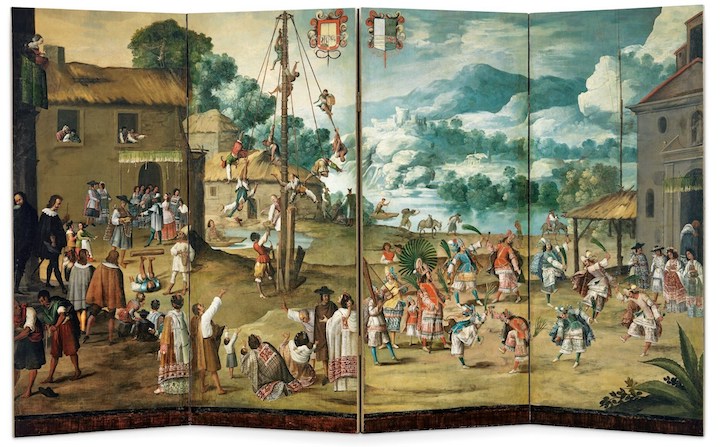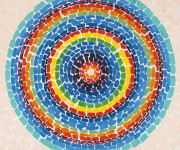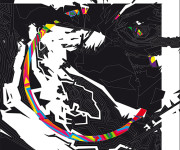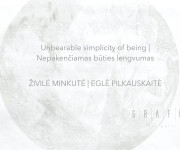The Frist Art Museum is proud to present “Art and Imagination in Spanish America, 1500–1800: Highlights from LACMA’s Collection,” an exciting exhibition showcasing a vibrant collection of paintings, sculptures, decorative arts, and more, all originating from the early modern era in Mexico, Central America, and South America. This marks a significant milestone in the world of art, as it unveils the extraordinary Spanish-American art collection from the renowned Los Angeles County Museum of Art (LACMA). The exhibition will grace the Frist’s Upper-Level Galleries, welcoming visitors from October 20, 2023, to January 28, 2024.

Unidentified artist (Mexico). Folding Screen with Indigenous Wedding, Mitote, and Flying Pole (Biombo con desposorio indígena, mitote y palo volador), ca. 1660–90. Oil on canvas; overall (4 panels): 66 × 120 in. Photo © Museum Associates/LACMA
This captivating exhibition, thoughtfully curated by Ilona Katzew, the curator and department head of Latin American Art at LACMA, features over 90 remarkable works hailing from Guatemala, Mexico, Peru, Colombia, and Ecuador. These works span a wide array of artistic mediums, and many of them are recent acquisitions. “Art and Imagination” invites visitors to delve into the multifaceted dynamics that gave birth to these powerful artworks, providing fresh insights into the creative brilliance of Spanish America and its influential role as a global cultural crossroads.
The early modern era, encompassing the years from about 1500 to 1800, was a period marked by seismic shifts, including imperial expansion, conquest, colonization, and the transatlantic slave trade. These transformations brought diverse cultures into close contact, igniting a vibrant evolution in material culture. After the Spanish colonization of the Americas in the late 15th century, artists in the region drew inspiration from a rich tapestry of traditions, fusing Indigenous, European, Asian, and African influences. This synthesis of cultures and ideas illuminated the early modern world’s interconnectedness. “Spanish America was neither a homogeneous nor a monolithic entity, and local artists were not passive absorbers of foreign traditions,” said Katzew. “Without ignoring the profound violence that marked the process of conquest and colonization, this exhibition and accompanying catalogue emphasize the intricate social, economic, and artistic dynamics that led to the creation of astounding artworks within the budding new societies.”
The Spanish conquest of a part of the Philippines in 1565 marked the inception of a commercial route that interconnected Asia, Europe, and the Americas. Homes, civic institutions, and religious spaces in Spanish America were adorned with a rich array of imported and locally crafted objects. These objects, in turn, embarked on global journeys, showcasing their universal appeal. This convergence of cultural treasures symbolized the significance of the Americas, as eloquently described by a contemporary author as “the world’s treasure trove.”
The exhibition features a treasure trove of captivating highlights. These include the recently acquired and meticulously restored Pietà by the Potosí (Bolivia) painter Melchor Pérez Holguín, a captivating folding screen depicting an Indigenous wedding scene near Mexico City, created by an anonymous 17th-century artist, and a series of striking works featuring mother-of-pearl, known as enconchados.
Structured thematically, the exhibition commences with “Eyes of the Imagination: Envisioning the Divine,” featuring grand devotional images, many of which were commissioned for altarpieces and monastic cycles within the Catholic church. While the church played a pivotal role in disseminating European religious themes, local artists brought their unique perspectives to these compositions, often intertwining them with local narratives. “Fashioning Identity” explores the use of costumes and artworks in shaping and reinforcing social and ethnic distinctions, exemplified by the 18th-century Mexican casta (caste) paintings. “Converging Materials” delves into the widespread influence of luxury goods from Asia and other regions, transformed with ingenuity by local artists, encompassing lacquerware and shell-encrusted paintings and furnishings. “The Art of Two Artists: The Culture of Copies” takes a close look at the tradition of creating pictorial reproductions by referencing both local and foreign source materials, a vital aspect of the creative process for artists. This tradition underscores the fluid exchange of images and ideas between Europe and Spanish America. The exhibition culminates with “Intimate Faiths,” presenting small-scale paintings, sculptures, and finely detailed badges that nuns and friars wore for private and domestic devotional purposes.






